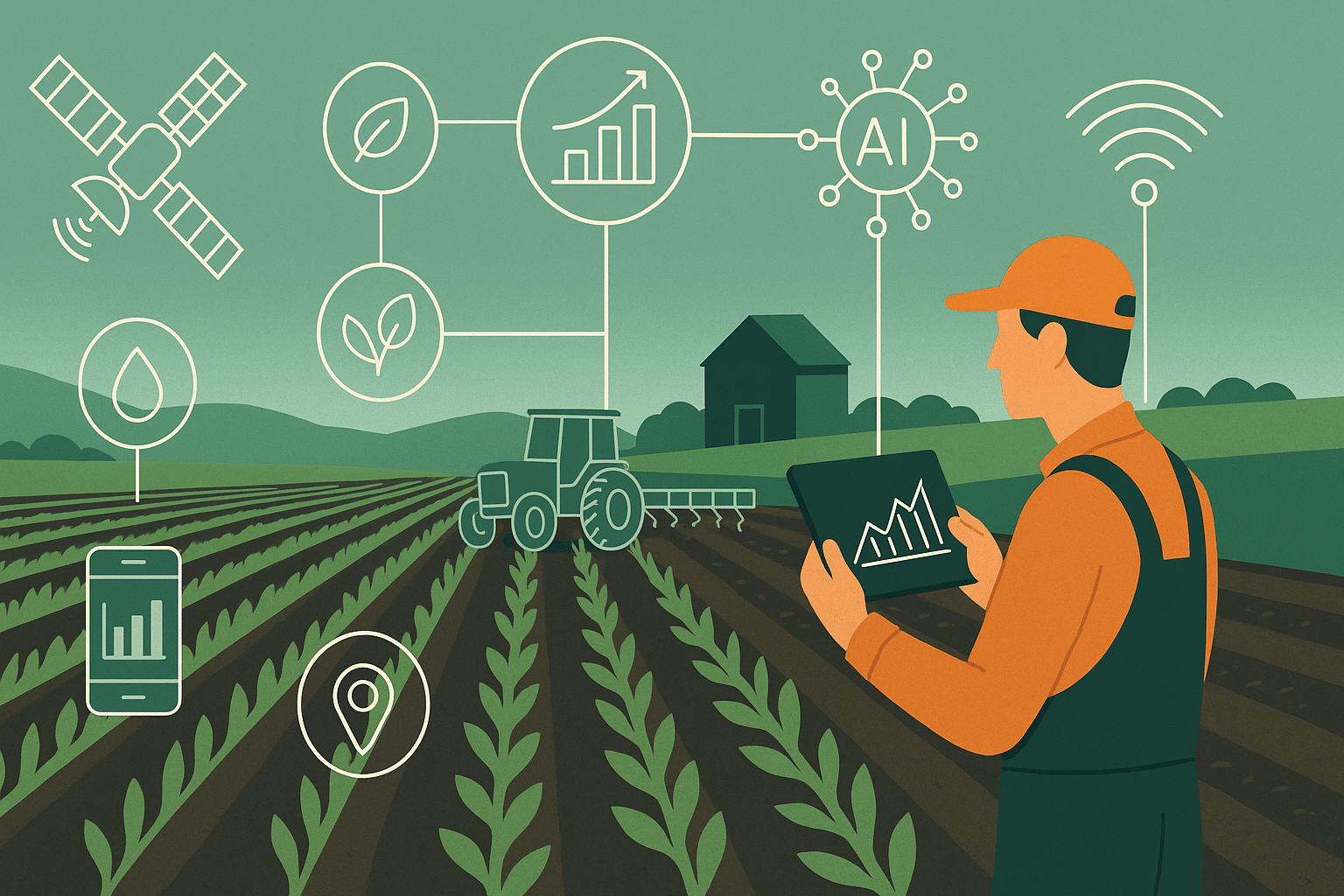Key Takeaways
- Digital agronomy integrates digital tools with agronomic expertise to support data-driven crop and soil management.
- Technologies such as sensors, GPS, remote sensing, and AI enable real-time monitoring and precision input application.
- Data management is essential for tackling climate change, improving productivity, and ensuring compliance and traceability.
- Digital agronomy platforms support complex decision-making by unifying data sources and offering predictive insights.
- Challenges include data fragmentation, infrastructure gaps, and the need for farmer training in digital tools.
What is Digital Agronomy?
Digital agronomy is a specialized discipline within digital agriculture that applies digital technologies and data science to optimize crop production and soil management. It integrates tools such as drones, GPS systems, field sensors, satellite imagery, and data analytics to capture and interpret high-resolution information from fields.
Unlike precision agriculture, which focuses on applying variable rate technologies to inputs, digital agronomy centers on combining agronomic knowledge with real-time digital insights. This enables farmers and agronomists to make data-driven decisions about planting schedules, fertilization, irrigation, and crop protection, ultimately enhancing productivity and sustainability.
How Does Digital Agronomy Work?
Digital agronomy operates through a synergy of advanced technologies and data science to inform agricultural practices. Sensors placed in fields monitor soil and crop conditions, while GPS mapping ensures precise navigation and variable input application. Remote sensing tools like drones and satellites collect high-resolution imagery, enabling early detection of stress or disease.
Data analytics platforms process this information to generate actionable insights. These are further enhanced by artificial intelligence and machine learning, which support yield forecasting and optimize decisions on crop protection. Mobile and ICT tools provide real-time data access, allowing farmers to make responsive decisions directly from the field.
Together, these tools shift agriculture from traditional methods toward a data-driven model of smart farming focused on efficiency, precision, and sustainability.
The Growing Need for Data Management in Agriculture
Modern farming operations face a rising demand for effective data management due to increased complexity, climate unpredictability, and the push for sustainability. Farms now generate large volumes of information from IoT devices, remote sensors, machinery, and environmental monitors. Managing this data effectively is crucial to ensuring optimal decisions can be made in real time.
Data systems help farmers navigate climate variability, market fluctuations, and regulatory requirements. They support sustainable input use, enabling farmers to do more with fewer resources while minimizing environmental impact. Moreover, organized data systems allow for traceability and accountability, addressing consumer and regulatory expectations.
Centralizing and automating data processes increases efficiency and supports collaborative efforts among agronomists, researchers, and farm operators. Ultimately, data management is a foundation for digital agronomy to fulfill its promise of smarter, more sustainable food production.
Digital Agronomy Platforms: Supporting Complex Data Needs
Digital agronomy platforms are designed to manage and synthesize complex agricultural data from multiple sources.
Integration of Multiple Data Sources
These platforms compile information from sensors, GPS, drones, satellite imagery, and historical yield maps to build a complete picture of field conditions.
Advanced Analytics and AI
AI models process large datasets to identify trends, generate prescriptions, and support automated decisions on input application, crop rotation, and pest management.
Real-Time Monitoring and Alerts
Continuous data feeds enable real-time tracking of crop development and soil conditions, sending alerts when anomalies arise.
Decision Support Systems (DSS)
DSS tools offer targeted recommendations for planting, irrigation, and harvesting based on predictive analytics.
Centralized Data Management
Central repositories reduce fragmentation and facilitate collaboration between farmers, agronomists, and suppliers.
Visualization and Reporting
Dashboards and interactive maps translate raw data into actionable formats, enabling faster and better decisions.
Data-Driven Decision Making in Agronomy
Data-driven agronomy allows farmers to move from intuition-based to evidence-based management, improving outcomes in key areas:
- Productivity: Optimizing input use enhances yields while reducing waste.
- Sustainability: Data supports targeted application of chemicals and water, reducing environmental impact.
- Risk Management: Predictive insights prepare farms for market and climate volatility.
- Compliance: Transparent records meet regulatory and consumer demands.
Benefits of Implementing Digital Agronomy
Digital agronomy delivers clear advantages across agricultural operations. By enabling precise input management, it improves yields while minimizing unnecessary costs. The use of digital tools ensures that resources like water, fertilizers, and pesticides are applied only when and where needed, enhancing both efficiency and profitability.
Environmental outcomes also benefit. Controlled input application reduces runoff and pollution, helping farmers meet sustainability targets. Additionally, access to predictive analytics supports better risk management, allowing for early responses to disease, pests, or extreme weather.
Digital agronomy tools streamline workflows by centralizing information and automating data interpretation. This not only boosts productivity but also empowers farmers and agronomists to make more confident, informed decisions while improving compliance and transparency in the supply chain.
Challenges in Digital Agronomy
Despite its advantages, digital agronomy faces several challenges:
- Data Fragmentation: Integrating diverse data sources remains technically complex.
- Infrastructure Gaps: Poor internet access in rural areas limits adoption.
- Data Security: Safeguarding sensitive farm data is increasingly critical.
- Interoperability: Lack of common standards between digital tools complicates system integration.
- Training and Support: Adoption depends on agronomists and farmers understanding how to interpret and act on digital insights.
Some Companies Offering Digital Agronomy Solutions
- Agrosmart: Specializes in climate intelligence and real-time crop monitoring, helping farmers make proactive decisions using data from multiple sources.
- Instacrops: Offers a full-stack platform integrating IoT, satellite, and drone data with AI and machine learning to deliver real-time agronomic recommendations.
- Farmonaut: Delivers satellite imagery, AI, and blockchain-based traceability for real-time crop health monitoring and resource optimization.
- Gamaya: Uses multispectral satellite and drone imagery for large-scale crop diagnostics and management, supporting smart farming at scale.
- AGRIVI: Provides comprehensive farm management software with real-time insights into field data, crop production, and supply chain management.
- EOS Data Analytics: Develops satellite-driven precision farming platforms for crop health monitoring and operational insights using AI and big data analytics.
Subscribe to our newsletter here.
Join our iGrow Network here.


